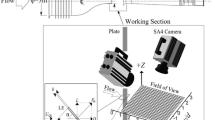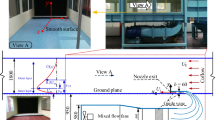Abstract
The Reynolds-averaged flow for a solid/free-surface juncture boundary layer and wake is documented. The three mean-velocity components and five of the Reynolds stresses are measured for a surface-piercing flat plate in a towing tank using a laser-Doppler velocimeter system for both boundary-layer and wake planes in regions close to the free surface. The experimental method is described, including the foil-plate model, laser-Doppler velocimeter system, conditions, and uncertainty analysis. The underlying flow data is in excellent agreement with benchmark data. Inner (near the plate and wake centerplane and below the free surface) and outer (near the free surface) regions of high streamwise vorticity of opposite sign are observed, which transport, respectively, high mean velocity and low turbulence from the outer to the inner and low mean velocity and high turbulence from the inner to the outer portions of the boundary layer and wake. For the wake, the inner region of vorticity is relatively weak. The physical mechanism for the streamwise vorticity is analyzed with regard to the Reynolds-averaged streamwise vorticity equation. The anisotropy of the crossplane normal Reynolds stresses closely correlates with the vorticity and, additionally, indicates similarity, i.e., its nature is such that it only depends on the proximity to the plate and free surface boundaries or wake centerplane symmetry plane. Free-surface effects on the Reynolds stresses are analyzed with regard to the behavior close to the free surface of the turbulent kinetic energy and the normal components of the anisotropy tensor and the anisotropy invariants. Close to the free surface, the turbulent kinetic energy is nearly constant and increases for the inner and outer portions, respectively, of the boundary layer and wake and the normal components of the anisotropy tensor and the anisotropy invariants roughly correspond to the limiting values for two-component turbulence. The similarities and differences between the present results and analysis with those from related studies are discussed. The data and analysis should have practical application with regard to the development of turbulence models for computational fluid dynamics methods for the Reynolds-averaged Navier–Stokes equations.
Similar content being viewed by others
Author information
Authors and Affiliations
Additional information
Received: 27 May 1997/Accepted: 1 August 1997
Rights and permissions
About this article
Cite this article
Longo, J., Huang, H. & Stern, F. Solid/free-surface juncture boundary layer and wake. Experiments in Fluids 25, 283–297 (1998). https://doi.org/10.1007/s003480050232
Issue Date:
DOI: https://doi.org/10.1007/s003480050232




